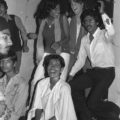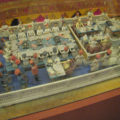Can a country have an inferiority complex? Certainly the US strongly feels its own superiority, and this is reflected in its media. As pointed out in a Doonesbury cartoon years ago, a lot of American advertising uses the word “America” to sell products that have nothing to do with nationality. Mike Doonesbury asks: “Why are Americans so insecure about themselves? Do any other countries make ads that are so relentlessly chauvinistic?”
As a matter of fact, they don’t – at least not that I’ve seen. But Mike had the wrong end of the stick: the driving force here is not insecurity, but pride. Americans have a strong sense of what it means to be American, and it’s the kind of warm, fuzzy feeling that makes advertisers want to create a link (in the public mind) between their product and “being American.”
Watching American TV, you might get the idea that American is not only the best thing to be, it’s the only thing to be. The American media tends to ignore the rest of the world, at least until forced by events to sit up and take notice.
To a point, this is understandable; most news organizations report to a local/national audience whose interest in faraway events is limited. In reports of, say, an airline disaster, the local news will say that “x number of people from our country were involved, x others;” I’ve seen this in both the UK and Italy. The disasters that no one local is likely to be involved in get short shrift indeed: “x thousand people killed in floods in Bangladesh. End of story.”
But the United States is the leading player on the world stage, so other countries’ news media report extensively on America’s affairs, both internal and external. What happens in America affects the world. (This, by the way, is a huge responsibility, but one that most Americans seem unaware that they carry.)
Italy, on the other hand, seems to have an inferiority complex. It’s the world’s fifth or sixth largest economy, yet Italians seem to feel that Italy doesn’t really deserve much of a position on the world stage. Maybe I’m just imagining things, but I get this impression most strongly from the Italian news media.
The US public probably would not have noticed that Italy sent troops to the Gulf War, but the Italian TV news gave “our boys” lots of coverage, partly, I suppose, because it was easier and cheaper to interview them than soldiers of other nationalities. But sometimes it felt as if the Italian journalists were like the nerdy kid who tries too hard to get noticed by the rest of the class: “See, see! We’re there, too!”
A couple of Italian pilots managed to do something newsworthy: they were shot down, captured, and beat up by the Iraqis. The Italian press was delirious: finally, we have something momentous to say about Italy’s participation in the war.
Italy’s lack of national self-esteem shows in other ways. There are some things that everyone acknowledges the Italians are good at: food, design, leather. But beyond that, many Italians are convinced that the Americans do it better. Back when I was with Incat Systems, a small Italian company bent on conquering the global CD-R software market, we had trouble selling our software to Italians; some thought that software from Italy couldn’t possibly be any good. When half of the company moved to California and the same Easy CD software had an American address on it, more Italians were eager to buy it: it’s American, it must be good. (Whether Italian or American, Easy CD went on to take the lion’s share of the worldwide CD-R market; that’s why Adaptec bought it.)
As far as American customers knew, Easy CD was always an American product. Years later, when Easy CD Creator 4 was released, the suggested retail price (SRP) was $99 in the US, with a $20 rebate. In Europe SRP was set at the after-rebate price of $79. I got vitriolic email from an American: “How dare you give a lower price to foreigners on an American product?”
My response was: “The original Easy CD Creator was the offspring of Easy CD, developed in Italy, and CD Creator, developed in Canada. Even today, of the engineering staff in California, at least half were not born in America. So what exactly is an ‘American’ product?”
Never heard from him again.





